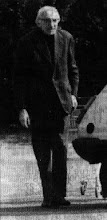During the nineteenth and twentieth centuries art reached an awareness of itself that developed contemporaneously with the need for a new kind of criticism, one requiring a judgement not simply as to whether a given work is deficient in this or that respect but as to whether the work in question is art at all. From the beginning of the nineteenth century, with the onset of Romanticism, art began to make the matter of its own status central to what constituted it, and by so doing incorporated the problematic and ambiguous into its very essence. One need look no further than the titles of the early masterpieces of European horror cinema, Nosferatu and Vampyr, or the American classics, Frankenstein and Dracula, to see that horror cinema is also a product of the Romantic movement. And it too confronts us with the question of its status: films were, and regularly still are, found to be offensive and trivial. Lacking the redemptive powers of art, they are thought especially worthy of censorship. Within this ethos, horror films are frequently linked with pornography, by critics and the censorious generally, as well as by the filmmmakers themselves, obvious examples being Franco and Buttgereit.
Condemned as trashily exploitative and sadistic, the films suffer as a consequence from mutilation, neglect and, what is worse, contempt. It is not to be denied that extreme violence, sexual degradation and grotesque forms of death are legion in the films of Argento, Cronenberg, Craven, Hooper, Fulci, Deodato, and many others, and yet I would argue that this is precisely the point: its confronting us with death presented in especially offensive and unacceptable ways, and its provoking of scandal and outrage, are what constitute the real significance of the horror film in our culture, and what of authentic value attaches to it attaches to these very images of death and dying.
*
Horror films have, on occasion at least, addressed themselves to the procedures and forms whereby they create what they create, and it is not too extravagant to suggest that films like Vampyr, Peeping Tom, Tenebrae and Dead Ringers exhibit an order of self-interrogation that has many features in common with the literature of modernism, features brought out by questions such as `why write all?' and `how can the act of writing be justified?' Within modernism, literature becomes literature only as it becomes a question as to what counts as literature, and in order to show something of the significance of this degree of self-questioning, both for literature and cinema, I want to begin by considering what I have already pointed to as one of the abiding preoccupations of Romantic and modern writing, the ground of representation itself.
To take a cinematic instance, the exploration of this issue is central to the project of Dreyer’s Vampyr. Aporia and contradiction are fundamental to it, and Dreyer accords them a particularly vivid and focused expression. The action of the film is situated ambiguously, in a world poised between life and death, in a landscape self-consciously created out of cinematic effects. For instance, Gray’s first walk to the mill is both a narrative event and at the same time a disruption of the logical sequence of that narrative event. The disruption of the intelligibility of the relations between the shadows, as the corporal’s shadow separates itself from his physical body, the sudden irruption of dance music and the appearance of what seem dancing cut-out figures, the commanding voice of the vampire, these and similar elements compromise the narrative order, rendering the narrative presentation suspect. This means that the narrative order of the film in its totality can no longer be trusted. The status of what we are seeing has become undecidable, and as a result the temporal progression of the events we see has also become uncertain, if not discredited. The only order of time that we can trust is the time it takes for the film to be seen, the time it takes for the reels of film to pass through the projector and to cast an image on the screen and to bring up sound through the speakers. It is in this sense that Vampyr can be said to resemble music. The action that is represented and the process of representing that action have been collapsed into one, so that the time it takes the events we see to elapse and the time it takes show us those events are the same. What Vampyr narrates, we might say, is the occurrence of the events that compose it, in the very instant that it is narrating the events themselves.
It is writing conceived of on the model of post-symbolist procedures that Vampyr most nearly answers to. It is when the events a poem narrates are the events that constitute its own unfolding that we are cast into what the French critic, Maurice Blanchot, has called a time before the world, before the beginning. In the symbolist poem, the work says what it says in the very gesture of saying what there is for it to say. The only happening in the poem is the happening of the poem itself: a world is described, and, in that same act of description or definition, created. Here, the act of creation turns back upon itself, becoming other than, and exterior to, itself. Hence it is possible neither to begin nor to end, since the words of the poem are already beyond themselves, elsewhere. As Eliot has it, in Burnt Norton: `the end precedes the beginning,/And the end and the beginning were always there/Before the beginning and after the end./And all is always now'. We cannot begin, since the beginning is always already begun, and we cannot come to an end, since the end is always already completed, in a time before the beginning. If, with Blanchot, we think of names on the Hegelian model, as effecting the murder or annihilation of the things they name, then the negation, by which the poem sustains itself and which in turn it sustains, must enter paradoxically into the poem, effecting its failure, and (in Blanchot's idiom) betraying the work of the poem to worklessness (désœuvrement). By this he means that the poem is split from itself, in a movement of double negation that turns it towards the outside, the exterior, beyond language and concept, where, as he puts it, there is no intimacy, no place to rest. The work says the nothing that is the condition of its simultaneous possibility and impossibility:
What are the roots that clutch, what branches grow
Out of this stony rubbish? Son of man,
You cannot say, or guess, for you know only
A heap of broken images . . .
The Waste Land, exemplary in this regard, is nothing other than what it constitutes itself as, namely `this stony rubbish', and the reader, caught within the language of the poem, unable to move beyond it, is, at the same time, exterior to it as it narrates the passage of its own negation:
A heap of broken images, where the sun beats,
And the dead tree gives no shelter, the cricket no relief,
And the dry stone no sound of water.
Blanchot's prose, which often reads like a rhapsodic commentary on The Waste Land, says of this mode of writing: `The work declares being - and says choice, mastery, form - by announcing art which says the fatality of being, says passivity, and formless prolixity'. At the conclusion of Vampyr, the mechanism driving the mill wheels that are drowning the doctor in flour finally stops, under its own volition and without visible cause. The doctor has been assimilated to the whiteness of the flour, a whiteness which is finally inseparable from a whiteness that has come to dominate the balance of light and shadow across the whole film, a fact made evident in the penultimate sequence, when Gray and Gisèle move across the water into the light of the dawn sun. As they step out of their boat onto the river bank, they walk into, and are transfigured by, the intensifying rays of light streaming through the forest. Suffusing the mist rising around the branches, the light comes to acquire almost as palpable a material presence as the objects it illuminates. And at this juncture, we cut back to the mill. The whiteness of the flour has by this time so filled the projected image that there appears no discernible difference between it and the whiteness of the screen behind the image, and it is in this moment of assimilation of the image to its support that the movement of the mechanism comes to a halt. The seeming coincidence of the image and the screen behind it is doubled by the fact that the movement of the mill gears and that of the projector showing the film also appear to coincide. The two movements collapse into a single duration, as the teeth of the gears and the sprockets of the projector gears appear to mirror one another, in a concurrence that effectively links an action internal to the film with an action external to it. It is as though the film were being completed in a time that had already been superseded, inasmuch as it has been this same action, the action of the mechanisms of the projector, that began the film and that has continued to sustain it throughout the time of its showing.
The Virtues of Knowledge
7 years ago


